Your cart is currently empty!
Incorporating Area Rugs into Your Bedroom Design: Essential Placement Tips

Incorporating an area rug into your bedroom design is more than just a decorative touch; it’s a strategic choice that can define your space, enhance comfort, and reflect your personal style. An ideal rug placement can create a sense of organization, warmth, and luxury in your bedroom. When done right, it’s remarkable how a simple piece of textile lying beneath your feet can transform the entire ambiance and functionality of your bedroom. Selecting the right size, texture, and pattern of the rug can complement the furniture and bedroom layout, making the rug a unifying element of your interior décor.
While selecting a rug for my bedroom, I consider both aesthetics and practicality. It’s important to choose a rug that not only matches the decor but also serves the intended purpose, like providing a plush surface when you first step out of bed. Establishing the right size is crucial; for a well-proportioned look, the rug should be large enough to frame your bed and possibly tie in other bedroom furniture. The placement should not be an afterthought. Aligning it with key pieces of furniture can bolster the symmetry and flow of the room. Strategizing the placement of the rug can also help in maximizing the comfort quotient of your bedroom, ensuring that the first thing my feet touch in the morning is a plush, warm surface rather than a cold, hard floor.
Key Takeaways
- An area rug significantly contributes to the bedroom’s design and comfort.
- Choosing the right rug involves considering size, texture, and bedroom layout.
- Strategic placement enhances room symmetry and ensures a cozy underfoot experience.
Understanding Bedroom Layouts for Rug Placement
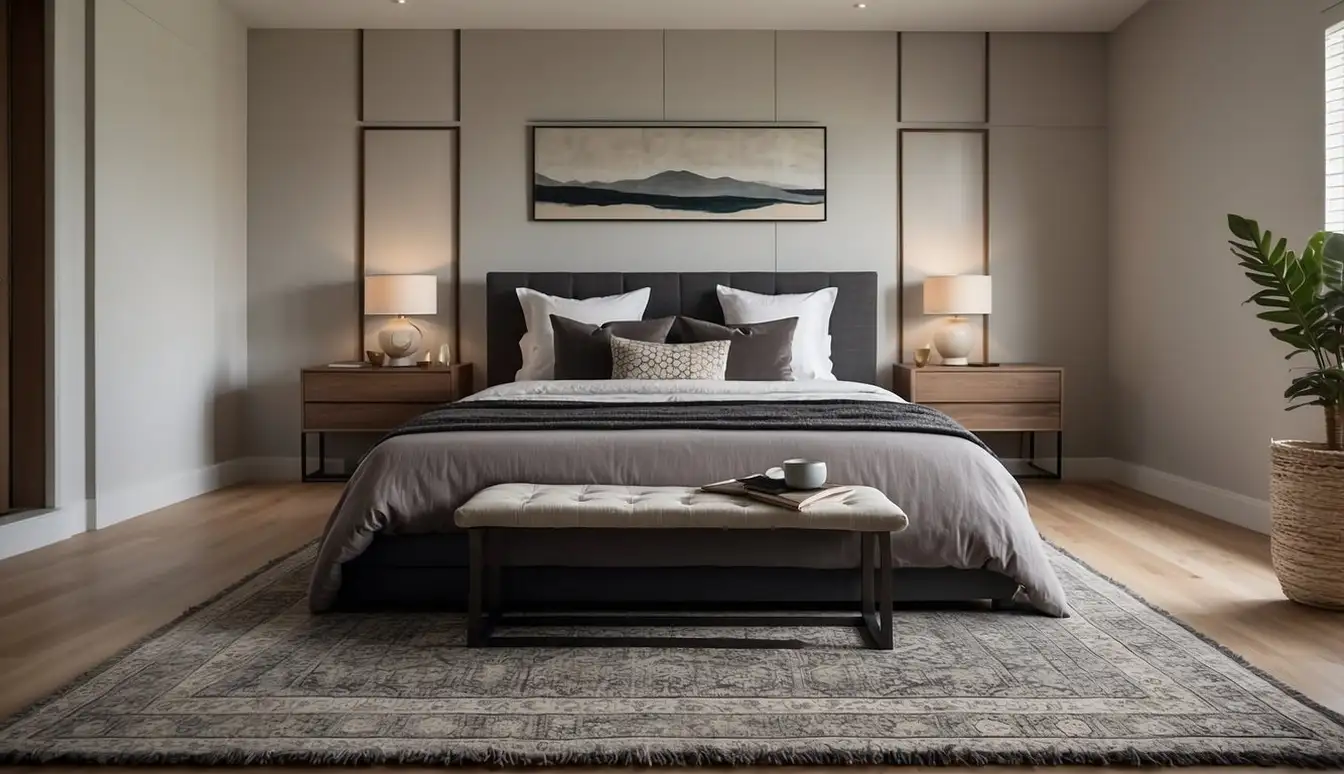
When I place a rug in a bedroom, I focus on bed dimensions and overall furniture arrangement to create a harmonious space. It’s about striking the right balance and ensuring the rug complements the bedroom’s layout and aesthetics.
Bed Size and Rug Proportion
For my queen-sized bed, I typically recommend a rug that extends at least 18 inches on either side, ensuring a balanced look. Here’s a quick reference table for bed-to-rug proportions that I like to use:
| Bed Size | Rug Size |
|---|---|
| Queen | 8′ x 10′ |
| King | 9′ x 12′ |
The larger the bed, like a king-sized one, the bigger the rug I choose, aiming for symmetry and proper scale.
Space Utilization and Furniture Arrangement
I consider the entire bedroom layout to ensure the rug maximizes both style and function. The correct size rug should anchor the bed and any surrounding furniture without overwhelming the space. In a smaller bedroom, I might position a smaller rug at the foot of the bed to avoid making the room feel cramped.
Positioning Rugs with Nightstands and Bedside Tables
With bedside tables, I find that placing the edge of the rug just under the bottom half of the tables creates a cohesive look. This prevents tripping hazards and completes the bedroom’s furnishing without hindering the functionality of the space.
Selecting the Right Rug for Your Bedroom
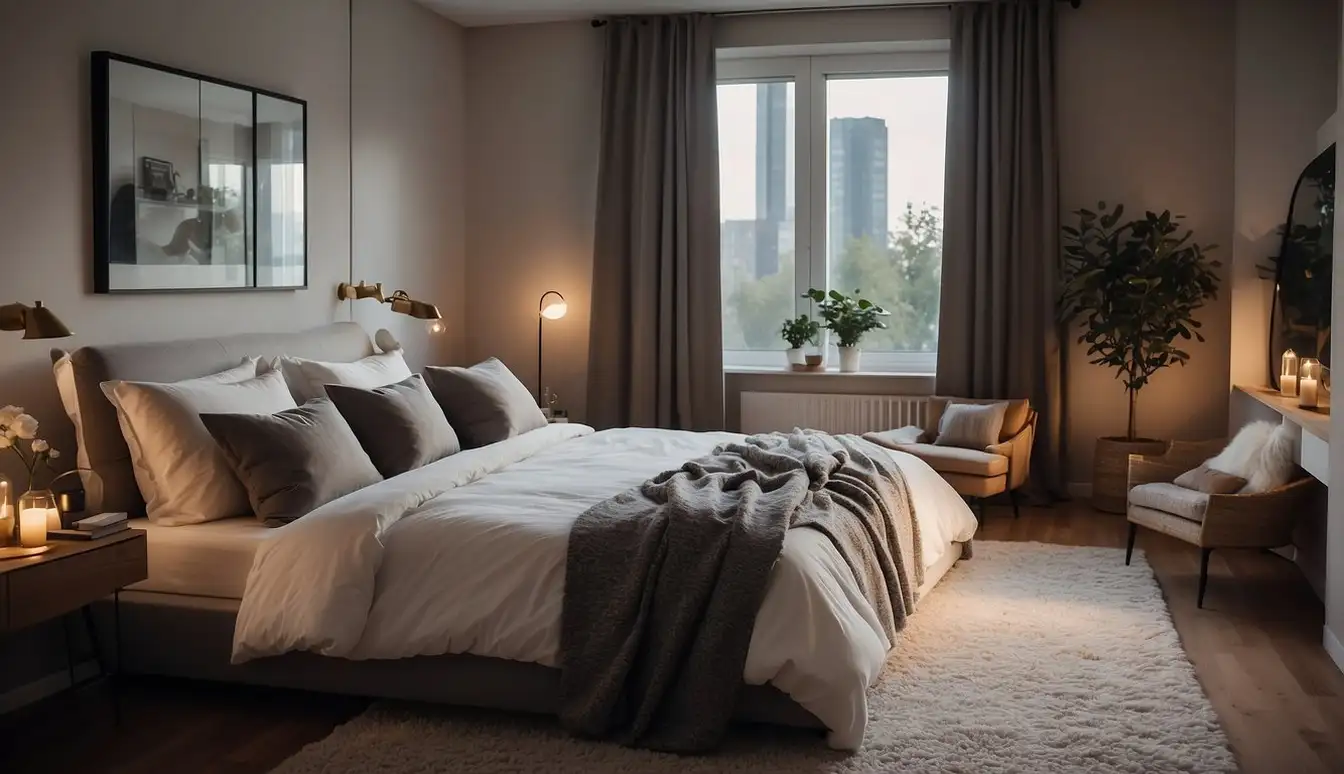
When I think about selecting the right rug for my bedroom, I focus on the harmony between function and design, ensuring the rug provides comfort underfoot while complementing the overall style of the room.
Choosing Materials and Textures
Selecting the material and texture of a rug is pivotal to how it feels and performs. For a cozy, plush feel underfoot, I often consider wool rugs because they’re soft, durable, and naturally stain-resistant. On the other hand, for a more budget-friendly option that’s still comfortable, synthetic fibers like polypropylene offer a good alternative. For those who prefer eco-friendly options, natural fibers such as jute or sisal provide a unique texture and add an earthy, organic element to the bedroom.
Considering Colors and Patterns
The color and pattern of a rug can significantly influence the mood of my bedroom. A rule I tend to follow is choosing a rug that complements my existing bedroom palette. Light colors can make a small bedroom feel larger, while darker hues create a cozy ambiance. Bold patterns can become a focal point, while subtle designs tend to blend seamlessly into the decor. I keep in mind that a bedroom is a place for rest, so I opt for colors and patterns that promote a calming atmosphere.
Rug Shapes and Dimensions
The shape and size of the rug should be proportionate to my bedroom’s layout. I prefer rectangular rugs for a traditional look and to fit the majority of bedroom layouts. A rectangular rug that is slightly wider than my bed frame by at least 18 to 24 inches on either side provides a balanced look and a soft landing for my feet each morning. For those with unique bedroom designs or smaller spaces, a round rug or square rug could be the perfect fit to add dimension or define a space. It’s important to consider the rug’s placement in relation to my furniture and ensure it enhances the room’s overall flow and aesthetic.
Ideal Placement Strategies
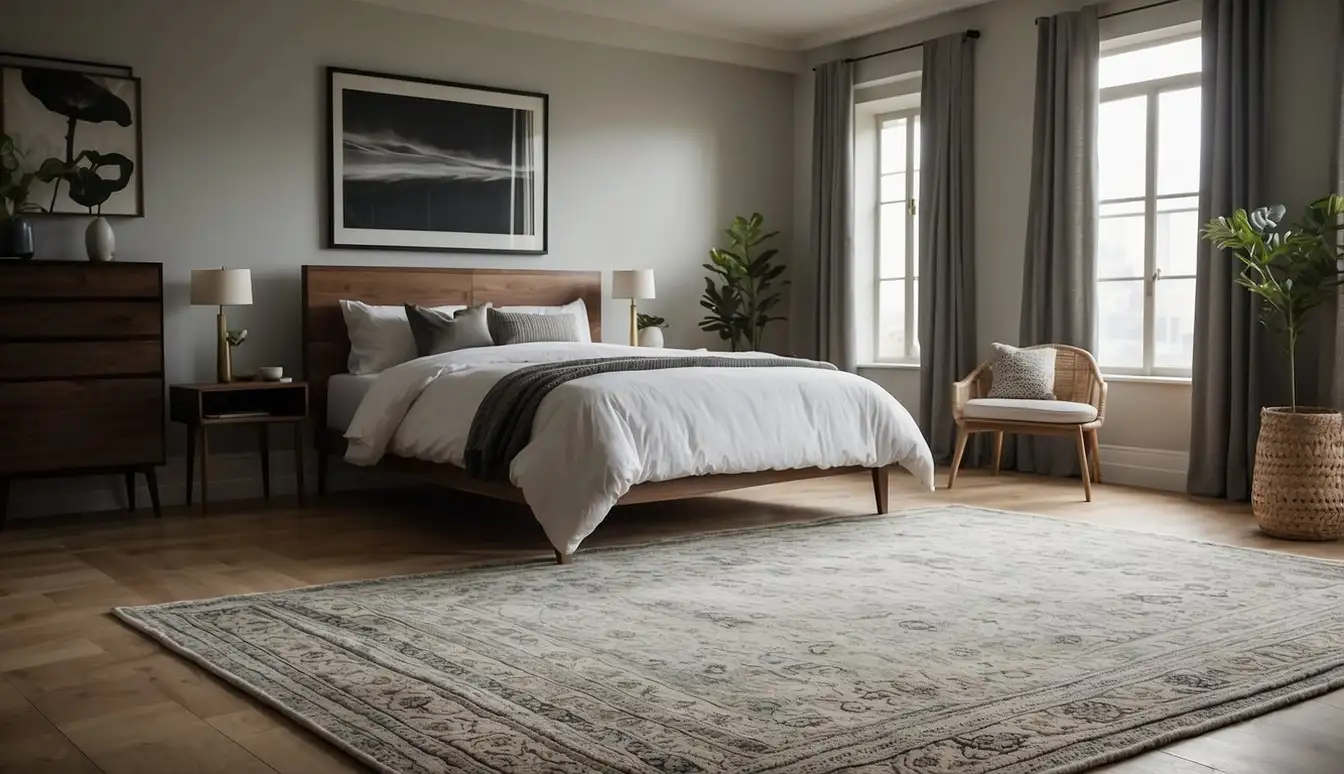
When incorporating area rugs into my bedroom design, I consider both function and aesthetics. My aim is to enhance comfort and define space effectively.
Runner Placement Options
Runners are a smart choice for adding warmth and color to my bedroom. I typically place a runner on either side of my bed to provide a soft landing for my feet in the morning. For a single side placement, I choose the side I use most frequently. Runners around two to three feet wide fit well in most scenarios.
Centering Rugs Under the Bed
For a harmonious bedroom layout, I center a large area rug under my bed. This creates a focal point and ensures an even border of bare floor between the rug edge and room walls. I’m mindful to choose a rug size that extends beyond the bed’s perimeter—usually 18 inches of rug exposure on all sides works best.
Layering Rugs for Added Dimension
Layering rugs introduces texture and depth to my bedroom. I select a large, flat-weave rug as the base and layer a smaller, textured rug on top. Sometimes, I opt for the half-on, half-off approach—involving the bottom two-thirds of my bed on the area rug—creating an invitation to the seating area. If I’m feeling creative, I don’t hesitate to double up multiple rugs for a unique look.
Maximizing Comfort and Aesthetics
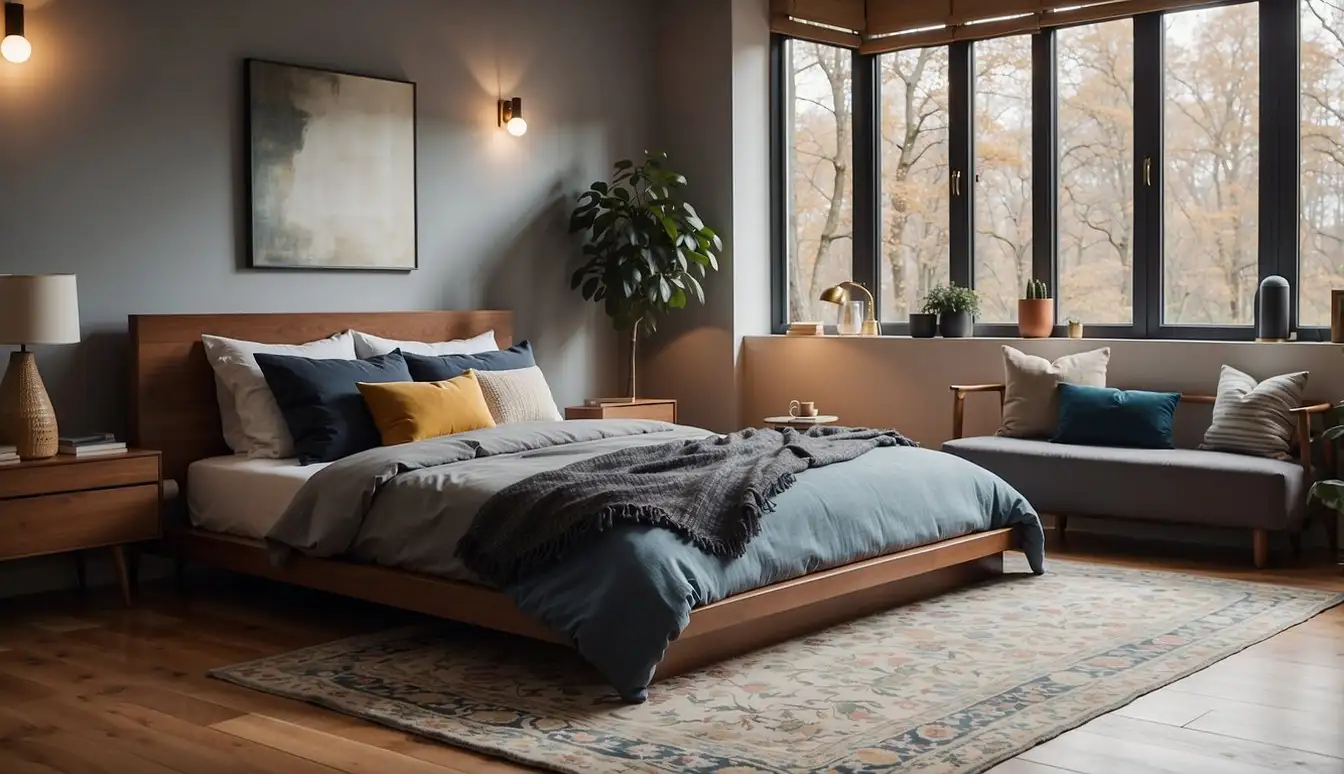
To me, effectively incorporating area rugs into the bedroom is about striking the perfect balance between cozy comfort and personalized style.
Balancing Style and Function
Functionality goes hand in hand with style when I choose an area rug for my bedroom. I aim to create a harmonious environment that reflects my personality while also catering to comfort. For instance, a plush rug beneath my bed makes my first steps in the morning warm and soft, enhancing the cozy factor in my master bedroom. Meanwhile, a bold rug can serve as a statement piece that pulls together the aesthetic of the room. It’s a careful mix where each choice, from the rug’s texture to its pattern, contributes to this balance.
Symmetry and Angled Arrangements
When I am arranging furniture and rugs in my bedroom, I’m particularly fond of symmetrical layouts as they instill a sense of calm and order. Placing an area rug parallel to the bed creates a visually anchored look that I find soothing. However, if I feel creative, I might place a round rug at an oblique angle to introduce an unexpected twist that still maintains a cohesive look. It’s a playful approach that can add an interesting dynamic to a room without upsetting its balanced design.
Choosing Rugs for Seasonal Shifts
I enjoy reflecting seasonal changes in my bedroom décor. During winter, a thicker, heavier rug lends extra warmth and comfort underfoot, doubling as a tactile indulgence on chilly mornings. Switching to lighter, airy rugs as the seasons change keeps my space feeling fresh. The material and weave of an area rug can transform the ambiance, making my bedroom suit the time of the year. This adaptability stands at the core of a truly comfortable and aesthetically pleasing bedroom environment.
Accessorizing with Rugs
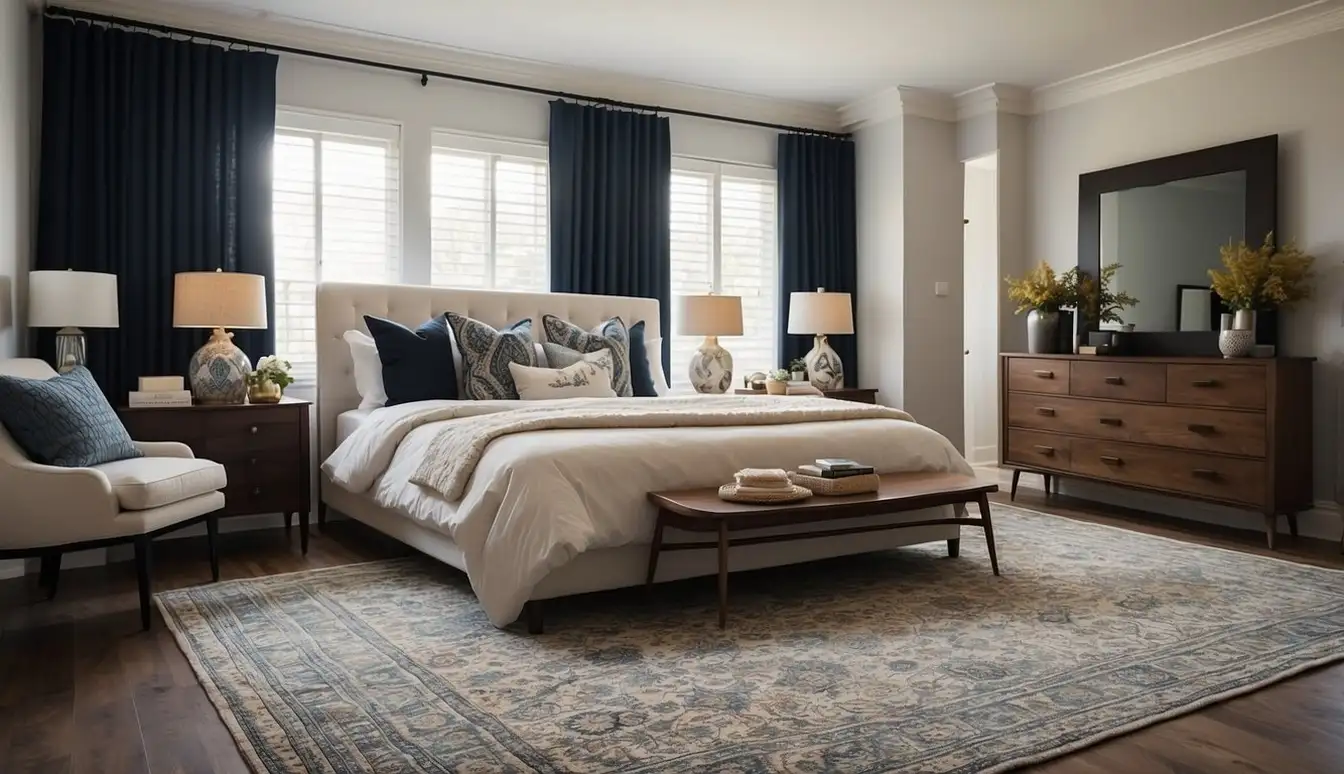
When I think of accessorizing a bedroom, rugs play a crucial role in tying together the aesthetics and enhancing the comfort. Their choice and placement can utterly transform the space.
Rugs as Decorative Accents
I’ve found that the right rug can serve as a beautiful focal point in a bedroom, much like a piece of art. If I’m dealing with a neutral color scheme, a rug with a bold pattern or vibrant colors can instantly elevate the room’s look. For a cohesive interior design, it’s essential to consider the size of the bed and rug. For instance, under a queen-sized bed, rectangular rugs that extend 18 inches beyond the sides of the bed provide balance and proportion.
– Rug Size Guide for Queen Beds:
- 6 x 9 feet: Leaves visible flooring, suitable for small to medium rooms.
- 8 x 10 feet: Offers generous coverage, ideal for larger bedrooms.
When using rugs as decorative accents, I also pay attention to the rug pad, ensuring it’s the right size to prevent slippage and add extra cushioning.
Incorporating Small Area Rugs and Runners
I love small area rugs and runners because they’re versatile decorative tools. A sheepskin rug or a slender runner beside the bed introduces an element of warmth and texture that’s highly inviting. I typically place them parallel to the bed, ensuring the length extends beyond the footboard to create an elongated effect. This also allows for the soft feeling of a rug underfoot, which is especially pleasant when I first wake up.
- Ideal Rug Runner Dimensions Beside the Bed:
- Width: 2 to 3 feet, to fit nicely alongside the bed.
- Length: Should surpass the bed’s footboard for visual continuity.
Incorporating these smaller rugs is also a clever move in my furniture layout strategy. They can act as transition pieces, leading the eye and feet from the bed to a seating area or the room’s entrance. Moreover, small rugs can be shifted easily, allowing me to refresh the room’s look without much effort.
Frequently Asked Questions
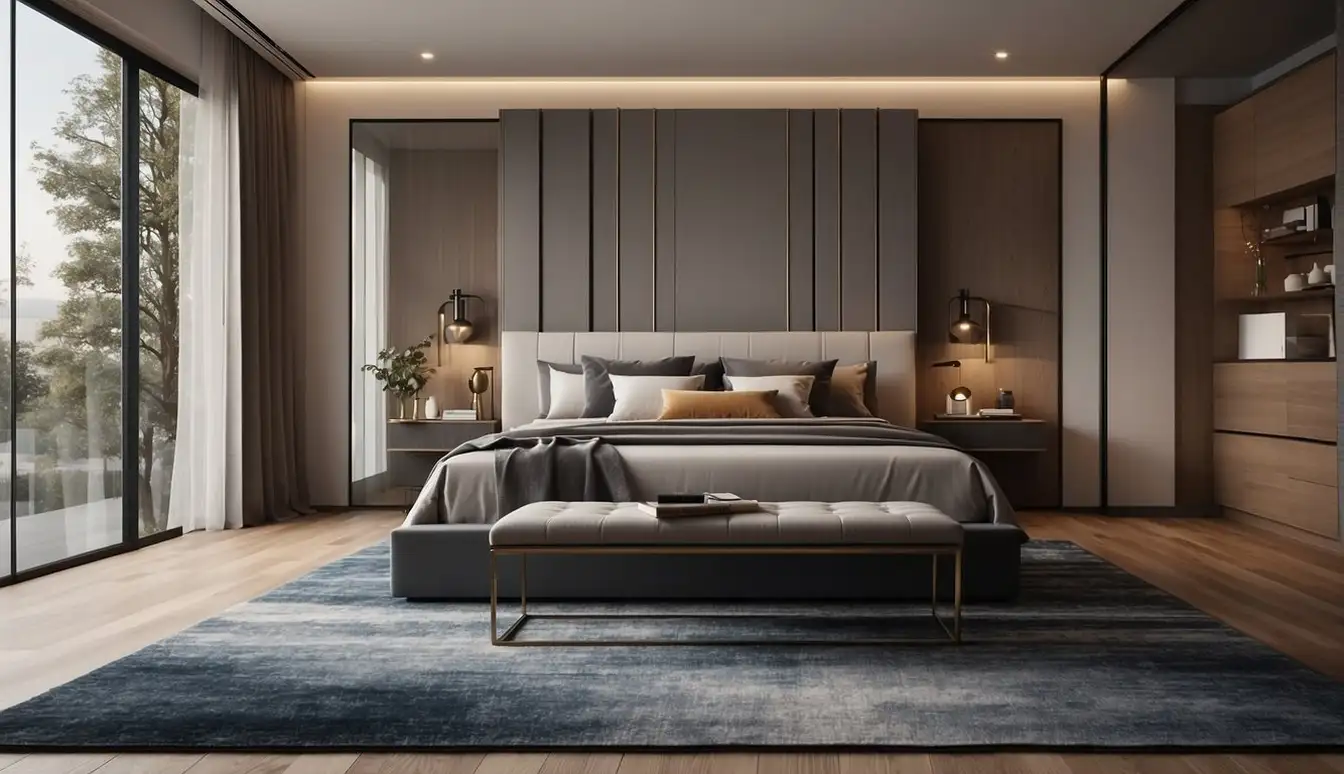
In my experience, the placement and size of area rugs can make a tremendous difference in the aesthetic and functionality of a bedroom. Let’s explore some common questions to ensure you’re making the most of your space.
What are some creative ways to position area rugs in a bedroom?
I’ve seen area rugs placed in various creative ways in bedrooms. A popular approach is layering rugs for a textured look or positioning a rug at an angle to create a dynamic feel. You can also place a runner along the side of the bed for an elongated effect, or put smaller rugs on each side if the room allows.
What size rug is appropriate for a bedroom with a king-sized bed?
For a king-sized bed, a rug that’s at least 8 x 10 feet offers balanced coverage. Ideally, you’ll want the rug to extend about 18 inches beyond the perimeter of the bed on at least three sides. This gives a luxurious feel and ensures a soft landing for your feet in the morning.
Can you give tips on the best rug placement for a bedroom with a queen-sized bed?
Sure! With a queen-sized bed, a 9- to 10-foot wide rug is often recommended so that it extends on either side. This allows for ample space to step onto after sleeping. Centering the rug under the bed ensures consistency and symmetry in design.
How should I place a rug in a small bedroom to maximize space?
In a small bedroom, choosing the correct rug placement is crucial. Opt for a smaller rug, like a 5 x 7 feet, and place it under the bottom two-thirds of the bed. This draws the eye across the room, helping to create the illusion of more space. Avoid too-large rugs that overwhelm the room and ensure there’s a little floor showing around the edges to define the area.
Are there specific guidelines for placing rugs in a bedroom according to feng shui?
Feng shui suggests that a rug under the bed should offer balance. For instance, it’s preferable to have it equally extend on both sides of the bed, ensuring harmony and stability. The color and texture should also contribute to a calming environment, supporting a restorative sleep.
How many area rugs can fit comfortably in one bedroom without it looking cluttered?
My guideline for the number of rugs in a bedroom without it appearing cluttered is usually one large rug or two smaller rugs if they’re appropriately placed. For example, you can have one large area rug under the bed and another small one at a seating area. Maintain a clear division of space to retain a cohesive and spacious look.
